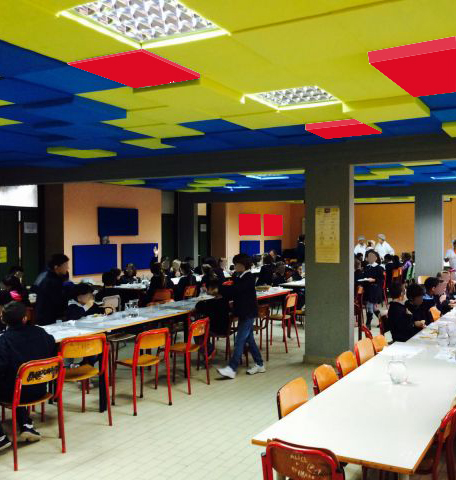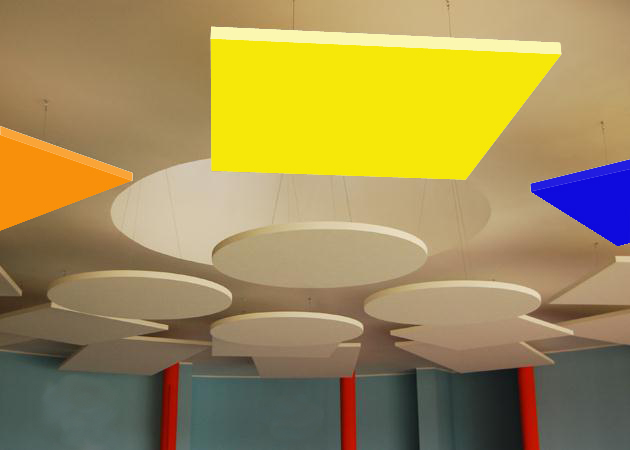 Up to now the D.M. 18/12/75, which constitutes the reference standard in this matter in Italy, still struggles to find an effective application.
Up to now the D.M. 18/12/75, which constitutes the reference standard in this matter in Italy, still struggles to find an effective application.
The relationship between teaching and space architecture is tight, a kindergarten properly designed acoustically can help children in their own learning process and can be a valid support for didactic activities offered by the teachers.
Children spend a good part of their time to the Kindergarten where they play, and often even daily, stop to eat. The moments of recreation are important: the lunch break is one of the most delicate moments because children tend to give vent to all their exuberance and the noise level reaches very high thresholds.
About that the recent studies have highlighted the impact of the noise factor on school canteens: in general they have shown a delay in learning. For this reason it is essential that the environment of the refectory is equipped to contain the inevitable background noise. The canteen is the place where children do not retain the screams and where they demonstrate their vitality through the noise and their vitality through the game. Children do not seek a quiet conversation with their classmates at the table, they rather seek a moment of leisure.
The basic problem to be solved within a canteen is to reduce the background noise for example acting on the reverberation time and at the same time acting on other factors such as the employment density of the room.
Kindergarten verbal communication is not only a means to convey information but it is also essential to establish relationships and socialize. The noise that makes complicated verbal communications may encourage the isolation of the child making it harder socialization, that’s the reason why "the sound environment" assumes a great importance.
 One of the most serious phenomena associated with the noise consists in the disruption of speech intelligibility that entails a significant bearing on the formation of students, especially the younger ones and in learning phase. In fact small subjects such as those of asylum being in a key moment for the intellectual development, are strongly affected by an inadequate acoustic environment because the lack of knowledge does not allow them to correctly reconstruct the parts of the verbal message masked by noise, with obvious consequences on the development of language.
One of the most serious phenomena associated with the noise consists in the disruption of speech intelligibility that entails a significant bearing on the formation of students, especially the younger ones and in learning phase. In fact small subjects such as those of asylum being in a key moment for the intellectual development, are strongly affected by an inadequate acoustic environment because the lack of knowledge does not allow them to correctly reconstruct the parts of the verbal message masked by noise, with obvious consequences on the development of language.
Then, when it comes to school , it’s fair to say that the acoustic comfort of the various rooms of the complex takes on an educational function as well as a great importance from the point of view of health.
Features such as the intensity, unpredictability uncontrollability of noise especially if protracted in time can have a negative impact on school-age children.
The noise to which children are subjected within an asylum, is a combination of outside noise and internally generated noise. It happens quite often that the predominant source of noise are the same kids, with sound levels caused by the activity carried out in that moment.

1) disturbances caused to children and teachers
2) impact on learning
3) problems of speech intelligibility
4) effects on health of teachers
Interventions should be targeted to the containment of the "reverberation time", reducing "diffused sound level ", as well as "multiples sound reflections" and increasing the " direct sound field ". To do this will be used materials with a high coefficient of absorption, especially at mid and high frequencies.
You will have to intervene in the classrooms, in the canteen, corridors and lobbies and in particular: on the ceilings, on the walls without windows and doors, in the working area of the cooks and the assistants. Will obviously be employed materials with characteristics of incombustibility, practicality, non- toxicity, inalterability, aesthetics.
 It is also very important the containment of noise due to trampling. In the case of a new building will need to employ a sound insulation material in floor slabs, carefully taking care of the installation. If it is comes to correct the acoustics of a building or an existing environment, the first step will be to establish the reverberation time. The acoustic design will provide solutions and materials suitable to bring that value to the optimal one in connection with the use of the environment itself. A final test will certify the results achieved.
It is also very important the containment of noise due to trampling. In the case of a new building will need to employ a sound insulation material in floor slabs, carefully taking care of the installation. If it is comes to correct the acoustics of a building or an existing environment, the first step will be to establish the reverberation time. The acoustic design will provide solutions and materials suitable to bring that value to the optimal one in connection with the use of the environment itself. A final test will certify the results achieved.
